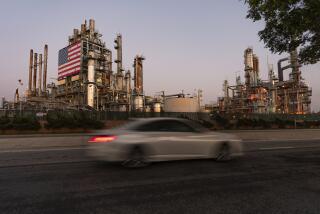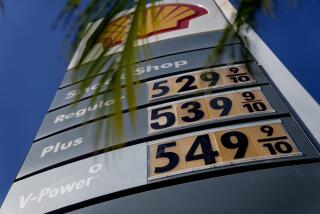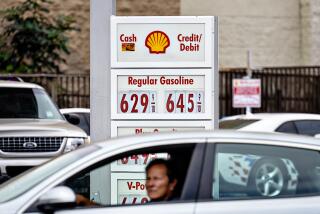Gas Jumped 10 Cents a Gallon in 3 Weeks Across U.S.
- Share via
LOS ANGELES — The price of a gallon of gasoline climbed more than a dime at the nation’s pumps in the past 3 weeks, spurred partly by fears of shortages due to the Alaska oil spill, an oil industry analyst said.
“Retail gasoline prices nationwide showed the largest and fastest price rise in the history of the U.S. gasoline market,” said Trilby Lundberg, whose Los Angeles-based Lundberg Newsletter regularly surveys more than 12,000 gasoline stations throughout the country.
Lundberg, in a telephone interview Sunday, said the average price of a gallon of gasoline, including taxes, jumped 10.24 cents, from 100.39 cents a gallon March 17 to 110.63 cents April 7.
“What we have just seen is an almost instantaneous national reaction to the brief cutoff of a quarter of the nation’s oil supply due to the disaster in Alaska,” she said.
Independent refiners were the first to experience oil shortages--especially in California, where 40% of the crude oil comes from Alaska--and prices jumped, she said.
Shortage fears accelerated the increased demand, and prices continued to rise until the flow of crude oil was resumed from Alaska.
Lundberg noted, however, that there were other contributing factors to the increase aside from the spill of 10.1 million gallons of oil March 24 when the Exxon Valdez struck a reef in Prince William Sound.
“The wholesale prices were rising noticeably prior to the Alaska disaster,” she said. “These price increases were the results of three elements. Cutbacks in refinery output, higher prices in the import markets . . . and finally, higher prices from U.S. refiners to head off possible shortages by dampening demand and thus preventing panic buying.”
The survey found that the average price at self-service stations--where over 80% of consumer gasoline sales are made--was 100.96 cents for regular unleaded, 115.80 for premium leaded and 100.56 for regular leaded.
At full-service stations, regular unleaded was 126.58, premium unleaded 138.07 and regular leaded 124.22.
Although there will probably be some stabilization now that oil shipments have resumed, Lundberg said that the factors that lead to price increases all year long are continuing and that further pressure will come once the summer driving season begins.
“The emergency is over. However, no one should expect an immediate drop of those 10 pennies, because of factors not related to the Alaska disaster, such as the relative stronger international crude oil prices and the seasonality of gasoline demand,” she said.
The only other time prices were at a level similar to the current price was in the beginning of 1980 after the Iranian oil embargo threatened supplies and sent spot markets soaring, she said.
The price kept rising and peaked out in March, 1981, at almost $1.38 a gallon. In early 1986, the price of crude oil crashed and the price of gasoline at the pumps plummeted.
More to Read
Sign up for Essential California
The most important California stories and recommendations in your inbox every morning.
You may occasionally receive promotional content from the Los Angeles Times.










